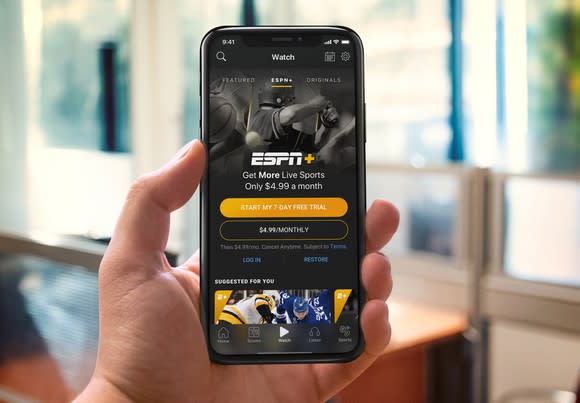Walt Disney Has Not Solved Its ESPN Problem
Walt Disney (NYSE: DIS) recently sent out a press release touting that its ESPN+ service has reached 1 million paid customers five months after its launch. On the surface, that seems like a success, but it's actually not even as big a milestone as it seems, and it's a drop in the bucket compared to where the company needs its over-the-top streaming to be.
The 1 million number itself isn't what it appears to be because it includes customers who already paid for ESPN's Insider service. How many people that is has not been disclosed, but ESPN+ did not get 1 million signups at $4.99 a month or $49.99 a year.
In reality, even if 1 million people signed up paying $4.99 a month, that's basically $5 million per month in revenue or $60 million a year. Of course, the actual revenue number is smaller, since some people likely paid the full-year-deal price, but in any event, the figure is a tiny drop in the bucket of what ESPN needs to take in to pay for ESPN+ -- let alone to get back to where it was.

ESPN+ has reached 1 million paying subscribers. Image source: ESPN.
How bad is ESPN's hole?
ESPN+ is not a digital version of ESPN. Instead, it's essentially another channel airing a mishmash of programming leftovers, digital shows that are sort of similar to ESPN cable shows, and premier programming like 15 second-tier UFC cards a year.
Just to get the UFC rights, Disney paid $150 million per year. That means that if you assume ESPN has no expenses beyond programming and subscription fees are all profit, the company needs more than 2.5 million full-fare customers just to pay for those rights.
UFC is not ESPN+'s only content deal. The company is also paying $55 million a year for various soccer league rights, and it has paid an undisclosed sum for a seven-year deal with Top Rank Boxing (with some programming airing on linear cable). On top of that, there are also various college rights deals, the cost of added studio programming, and likely more rights deals to come.
Additionally, ESPN has lost roughly 13 million cable subscribers since 2011, according to The Hollywood Reporter. ESPN has different deals with each cable company, but it's fair to say it gets roughly $8 per subscriber. That means that it has lost roughly $88 million per month in subscriber fees (and the number is higher when you factor in the other ESPN channels).
It's a start, right?
ESPN+ has a long way to go before it even breaks even. It makes some sense to celebrate 1 million paying customers (no matter how you got there), but until there's a zero after the one or at least something close to that, you can't deem this project a success.
The real milestones here will be how long it takes the company to get the next million and what sort of growth rate it can maintain. Disney has not proven there's a demand for this content beyond diehard fans of the various sports (and maybe a few Katie Nolan fans).
To show that ESPN+ is part of an overall ESPN turnaround, Disney needs to deliver numbers that are well higher than 1 million subscribers. That's not to say it won't, but it's going to be an uphill battle with a product that's an add-on at best, not a true replacement for ESPN.
More From The Motley Fool
Daniel B. Kline has no position in any of the stocks mentioned. The Motley Fool owns shares of and recommends Walt Disney. The Motley Fool has a disclosure policy.
